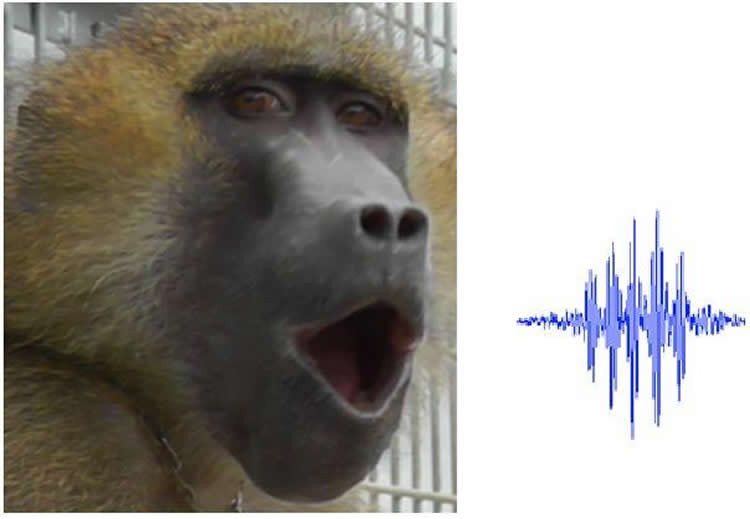Summary: Much like humans, baboons use several vowel like sounds to communicate, a new study reports.
Source: PLOS.
Acoustic and anatomic analyses suggest speech-like sounds in a closely related nonhuman primate.
An acoustical analysis of the grunts, barks, wahoos, copulation calls, and yaks from baboons shows that, like people who use several vowels during speech, these nonhuman primates make five distinct vowel-like sounds, according to a study published January 11, 2017 in the open-access journal PLOS ONE by Louis-Jean Boë, Grenoble Alpes University, France, and colleagues.
A prevalent idea on the origin of speech is that the low human larynx is required to be able to produce sets of distinct vowels, and that the high larynx of nonhuman primates prevents them from producing the vowels found across human languages. Thus, scientists believe that language originated relatively recently, within the last 70,000 -100,000 years, and little research on links between the vocalization of nonhuman primates and human speech has been undertaken. To investigate any such parallels, Boë and colleagues analyzed 1335 spontaneous vocalizations produced by 15 male and female Guinea baboons in different social contexts, and studied the anatomy of vocal tracts from two baboons that died of natural causes.

The researchers found that baboons produce five sounds that have important similarities with the vowels of human speech. People form each vowel sound with a precise control of tongue position in the vocal tract, and the anatomical analysis revealed that baboon tongues have the same muscles as human tongues. This suggests that these monkeys likewise use tongue movements to form each of the vowel-like sounds. Taken together, these findings suggest that spoken language in people may have evolved from articulatory capacities that were already possessed by our last common ancestor with baboons, or about 25 million years ago.
“Similarities between humans and baboons suggest that the vowels of human speech probably evolved from ancient articulatory precursors that were passed on and refined all along the hominid line,” says co-author Joel Fagot.
Funding: Research was supported by grants ANR-11-LABX-0036 (BLRI) and ANR-11-IDEX-0001-02 (A*MIDEX). CK was supported by a BLRI research post-doctoral grant.
Competing Interests: The authors have declared that no competing interests exist.
Source: Daniel Luzer – PLOS
Image Source: NeuroscienceNews.com image is credited to Joel Fagot.
Original Research: Full open access research for “Evidence of a Vocalic Proto-System in the Baboon (Papio papio) Suggests Pre-Hominin Speech Precursors” by Louis-Jean Boë, Frédéric Berthommier, Thierry Legou, Guillaume Captier, Caralyn Kemp, Thomas R. Sawallis, Yannick Becker, Arnaud Rey, and Joël Fagot in PLOS ONE. Published online January 11 2017 doi:10.1371/journal.pone.0169321
[cbtabs][cbtab title=”MLA”]PLOS “Baboon Vocalizations Contain Five Vowel-Like Sounds Comparable to Those of Human Speech.” NeuroscienceNews. NeuroscienceNews, 11 January 2017.
<https://neurosciencenews.com/baboon-communication-speech-5921/>.[/cbtab][cbtab title=”APA”]PLOS (2017, January 11). Baboon Vocalizations Contain Five Vowel-Like Sounds Comparable to Those of Human Speech. NeuroscienceNew. Retrieved January 11, 2017 from https://neurosciencenews.com/baboon-communication-speech-5921/[/cbtab][cbtab title=”Chicago”]PLOS “Baboon Vocalizations Contain Five Vowel-Like Sounds Comparable to Those of Human Speech.” https://neurosciencenews.com/baboon-communication-speech-5921/ (accessed January 11, 2017).[/cbtab][/cbtabs]
Abstract
Evidence of a Vocalic Proto-System in the Baboon (Papio papio) Suggests Pre-Hominin Speech Precursors
Language is a distinguishing characteristic of our species, and the course of its evolution is one of the hardest problems in science. It has long been generally considered that human speech requires a low larynx, and that the high larynx of nonhuman primates should preclude their producing the vowel systems universally found in human language. Examining the vocalizations through acoustic analyses, tongue anatomy, and modeling of acoustic potential, we found that baboons (Papio papio) produce sounds sharing the F1/F2 formant structure of the human [ɨ æ ɑ ɔ u] vowels, and that similarly with humans those vocalic qualities are organized as a system on two acoustic-anatomic axes. This confirms that hominoids can produce contrasting vowel qualities despite a high larynx. It suggests that spoken languages evolved from ancient articulatory skills already present in our last common ancestor with Cercopithecoidea, about 25 MYA.
“Evidence of a Vocalic Proto-System in the Baboon (Papio papio) Suggests Pre-Hominin Speech Precursors” by Louis-Jean Boë, Frédéric Berthommier, Thierry Legou, Guillaume Captier, Caralyn Kemp, Thomas R. Sawallis, Yannick Becker, Arnaud Rey, and Joël Fagot in PLOS ONE. Published online January 11 2017 doi:10.1371/journal.pone.0169321






